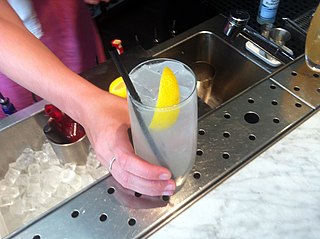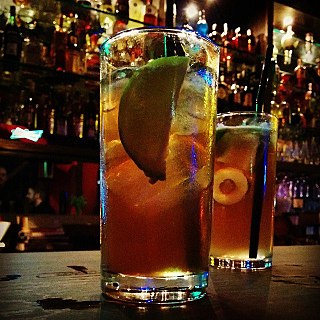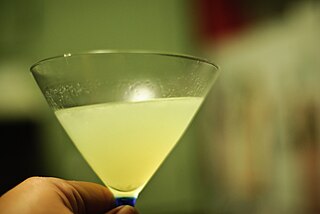
A gin and tonic is a highball cocktail made with gin and tonic water poured over a large amount of ice. The ratio of gin to tonic varies according to taste, strength of the gin, other drink mixers being added, etc., with most recipes calling for a ratio between 1:1 and 1:3. It is usually garnished with a slice or wedge of lime. To preserve effervescence, the tonic can be poured down a bar spoon. The ice cools the gin, dulling the effect of the alcohol in the mouth and making the drink more pleasant and refreshing to taste.

The Tom Collins is a Collins cocktail made from gin, lemon juice, sugar, and carbonated water. First memorialized in writing in 1876 by Jerry Thomas, "the father of American mixology", this "gin and sparkling lemonade" drink is typically served in a Collins glass over ice. A non-alcoholic "Collins mix" mixer is produced, enjoyed by some as a soft drink.

A Long Island iced tea or Long Island ice tea is a type of cocktail typically made with vodka, tequila, light rum, triple sec, gin, and a splash of cola, which gives the drink the same amber hue as iced tea.

A margarita is a cocktail consisting of Tequila, triple sec, and lime juice often served with salt on the rim of the glass. The drink is served shaken with ice, blended with ice, or without ice. The drink is generally served in a stepped-diameter variant of a cocktail glass or champagne coupe called a margarita glass.

French 75 is a cocktail made from gin, champagne, lemon juice, and sugar. It is also called a 75 Cocktail, or in French simply a Soixante Quinze.

The sidecar is any cocktail traditionally made with cognac, orange liqueur, plus lemon juice. In its ingredients, the drink is perhaps most closely related to the older brandy crusta, which differs both in presentation and in proportions of its components.

The Singapore sling is a gin-based sling cocktail from Singapore. This long drink was developed sometime before 1915 by bartender Ngiam Tong Boon, who was working at the Long Bar in Raffles Hotel, Singapore. It was initially called the gin sling – a sling was originally a North American drink composed of spirit and water, sweetened and flavored.

White lady is a classic cocktail that is made with gin, cointreau or Triple Sec, fresh lemon juice and an optional egg white. It belongs to the sidecar family, made with gin in place of brandy. The cocktail sometimes also includes additional ingredients, for example egg white, sugar, cream, or creme de menthe.

A "fizz" is a mixed drink variation on the older sours family of cocktail. Its defining features are an acidic juice and carbonated water. It typically includes gin or rum as its alcoholic ingredient.

A greyhound is a cocktail consisting of grapefruit juice and gin mixed and served over ice. If the rim of the glass has been salted, the drink is instead called a salty dog.

The last word is a gin-based Prohibition-era cocktail originally developed at the Detroit Athletic Club. While the drink eventually fell out of favor, it enjoyed a renewed popularity after being rediscovered by the bartender Murray Stenson in 2004 during his tenure at the Zig Zag Café and becoming a cult hit in the Seattle area.

A Clover Club cocktail is a shaken cocktail consisting of gin, lemon juice, raspberry syrup, and egg white. The egg white acts as an emulsifier, forming the drink's characteristic foamy head.

The Casino is an IBA official cocktail made with gin, maraschino liqueur, orange bitters and fresh lemon juice.
The Blackthorn is an Irish whiskey or sloe gin based cocktail. Both versions emerged in the late 19th and early 20th century.
The diki-diki is a cocktail made with calvados, Swedish Punsch, and grapefruit juice, dating back to the 1920s where it was popular in London's higher-end American var scene but is now more commonly served as a Tiki drink. The original recipe calls for shaking the ingredients with ice in 2:1:1 proportions, although many later variations have modified the ratio to greater emphasize the calvados as the base ingredient (4:1:1).

The doctor cocktail is a pre-prohibition era cocktail that traces in drink guides to as far back as 1917, when it appeared in Hugo R. Ensslin's Recipes for Mixed Drinks. As originally described the cocktail called simply for Swedish Punsch mixed with lime juice.
Arsenic and Old Lace is a classic cocktail with its origins in the 1910's made with gin, crème de violette, dry vermouth and absinthe.

The craft cocktail movement is a social movement spurred by the cocktail renaissance, a period of time in the 21st century characterized by a revival and re-prioritization of traditional recipes and methods in the bar industry, especially in the United States. The renaissance spanned from 2004 into the late 2010s. By 2017, high-quality ingredients, techniques, and liquors began to be ubiquitous in bars across the United States, leading writers to declare the renaissance over.
















